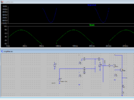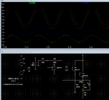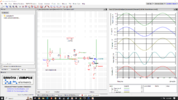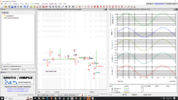why does the sim (.asc file attached) show an output of twice of what I am measuring in the constructed circuit?
But how is this related to the offset, or some other factor?
The simulation uses a
model of the real circuit (opamp). Any model makes simplifications to speed up simulation time. Example: set the supply voltage V1 to 9 V:

The simulation shows an output voltage of 8 V whereas in a real circuit the output voltage of the opamp is limited to ~ 7 V (V1 - 2V), cf. post #13 or see the datasheet. Subtract 2 × B
BE for the base-emitter juctions of Q1 and Q2 the output at the emitter of Q2 can be max. ~ 5.8 V.
Or in other terms for the output voltage to reach 9 V, the opamp's output voltage needs to be at least 10.2 V. Add the top margin of ~ 2 V ( Vsupply - Vopamp) and the supply voltage needs to be at least 12.2 V (minimum) or 13.2 V when assuming a 3 V margin (again, see the datssheet).
The simulation also shows the voltage at the output of the opamp to go to -100 kV. You do agree that this is unrealistic, do you?
You need to be aware of the limitations of a simulation. Any simulation needs to be taken with a grain of salt, especially when the real circuit shows a different behavior. Looking not only at the obvious points of interest (Vout) but inspecting other nodes as well helps to identify potential issues (Vopamp).





